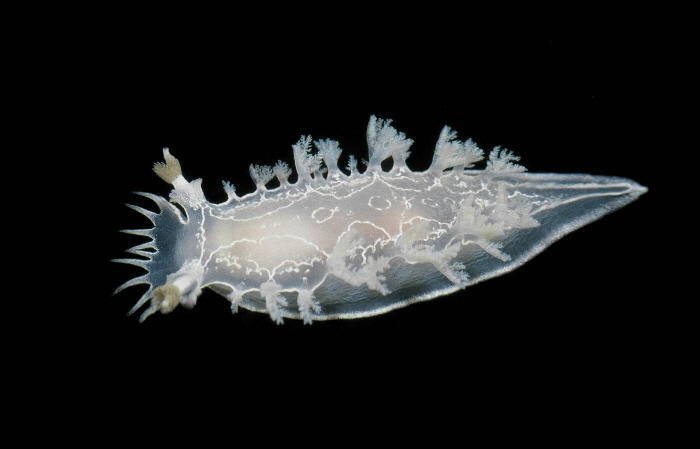 |
Photo courtesy of Jeff Goddard
Specimen collected at Cape Arago, Oregon
Tritonia festiva (Stearns, 1873)
Nudibranchs of the family Tritoniidae prey on soft corals, gorgonians and other octocorallian anthozoans. Their digitate frontal veil is extremely sensitive and used for locating expanded polyps of their prey and for carefully positioning the mouth over these in preparation for a surprise attack. The ensuing attack is remarkably rapid, as the slug lunges into the colony and bites off polyps before they contract into the protective cover of the spiculate colony mass. Tritonia festiva will not attack contracted colonies, and severed polyps are eventually regenerated by all but the smallest octocoral colonies.
Tritonia festiva is an opportunistic predator and feeds on every octocoral known intertidally from its North American range. These include the soft corals Alcyonium rudyi and Gersemia rubiformis, the mat-forming and recently described stoloniferan Cryptophyton goddardi (= Clavularia sp. of Ricketts et al., 1985), and an undescribed stoloniferan in southern California (McDonald & Nybakken, 1978; Jaeckle, 1984; Goddard, 1984, 1998, unpublished observations). Subtidally, Tritonia festiva has been reported feeding on the sea pen Ptilosarcus gurneyi and the gorgonian Lophogorgia chilensis (Gomez, 1973; Birkeland, 1974). The gill tufts of Tritonia festiva closely resemble the expanded polyps of Alcyonium rudyi, and when viewed from an oblique angle the nudibranch is quite cryptic among the colonies of this abundant northeastern Pacific species.
Tritonia festiva can escape from predatory seastars like Pycnopodia helianthoides and Solaster dawsoni by swimming off the substratum (Birkeland, 1974; T. A. Wayne, personal communication).
The egg mass of Tritonia festiva is a thin delicate rosette. Its egg capsules, unlike those of most nudibranchs, are not embedded in a jelly matrix but float free inside the fluid filled cord. Planktotrophic veliger larvae hatch after 12 days at 14 to 17 degrees C (Goddard, 1984).
Tritonia festiva ranges from south-central Alaska to northern Baja California (McDonald, 1983). Intertidally it grows to about 35 mm in length (personal observations).
References:
Birkeland, C. 1974. Interactions between a sea pen and seven of its predators. Ecological Monographs 44:211-232.
Goddard, J. H. R. 1984. The opisthobranchs of Cape Arago, Oregon, with notes on their biology and a summary of benthic opisthobranchs known from Oregon. The Veliger 27(2):143-163.
Goddard, J. H. R. 1998. A summary of the prey of nudibranch molluscs from Cape Arago, Oregon. Opisthobranch Newsletter 24:11-14.
Gomez, E. D. 1973. Observations on feeding and prey specificity of Tritonia festiva (Stearns) with comments on other tritoniids (Mollusca: Opisthobranchia). The Veliger 16:163-165.
Jaeckle, W. B. 1984. The opisthobranch mollusks of Humboldt County, California. The Veliger 26:207-213.
McDonald, G. R. 1983. A review of the nudibranchs of the California coast. Malacologia 24:114-276.
McDonald, G. R. & J. W. Nybakken. 1978. Additional notes on the food of some California nudibranchs with a summary of known food habits of California species. The Veliger 21(1):110-119.
Ricketts, E. F., J. S. Calvin & J. W. Hedgpeth. 1985. Between Pacific Tides. 5th ed. Revised by D. W. Phillips. Stanford University Press: Stanford, California.
Williams, G. C. 2000. A new genus and species of stoloniferous octocoral (Anthozoa: Clavulariidae) from the Pacific coast of North America. Zoologische Mededelingen 73:333-343.
Taxonomic Information and photos courtesy of Dr. Jeff Goddard

|
Dr. Jeff Goddard |
